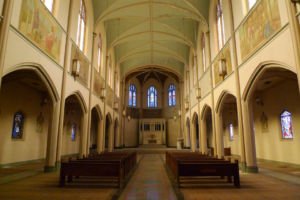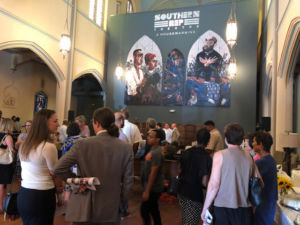Originally published by Brad Stanhope of Novogradac & Company, LLC on Wednesday, January 9, 2019
A church-and-school campus in New Orleans that never reopened after Hurricane Katrina is now home to the Southern Rep Theatre, a school, and a co-working space, thanks to equity from historic tax credits (HTCs) and new markets tax credits (NMTCs).
St. Rose de Lima Church became the Rose Collaborative when it opened in October.
“Adaptive reuse, if it’s done right, can be wonderful,” said Shawn Kennedy, president of Rose Community Development Corporation (Rose CDC), a partner in the development. “I think in some regards, this is the overall idea of what we wanted. In some regards, it’s better.”
“Church buildings are going empty across the country and it’s extremely hard to find alternative uses,” said Nancy Wagner-Hislip, chief investment officer of the Reinvestment Fund, which provided key financing for the development. “It was an opportunity to redevelop that building that was a blight–it was a pretty blight, but a blight–on the neighborhood and give the theater group a permanent home.”
It is a story that starts long before Katrina hit New Orleans.
Early 20th Century to Acquisition
St. Rose de Lima Church was built in 1915. Over many decades, the campus served as a spiritual center for the community, as well as the home of a school–which had buildings constructed in 1925 and 1938.
The property remained vital, but changing demographics and dropping school attendance had it struggling by 2005. Then Katrina hit, damaging the city–although the property, on high ground, avoided dramatic damage. The church never reopened and the Archdiocese of New Orleans deconsecrated the property, making it available.
Kennedy and her husband, Hal Brown, had retired to New Orleans in 2004 and Brown was involved in the rebuilding effort after Hurricane Katrina. He joined the Downtown Neighborhoods Improvement Association, which sought properties that could be put back in use. This building was a natural fit, although it took the creation of Rose CDC before site control was secured with a lease agreement that included a purchase option.
“Following Katrina, a group of leaders identified this closed, deconsecrated diocese property that is on a critical cultural corridor, to create an arts and culture project,” said Jonathan Leit, director of the New Orleans office of Alembic Community Development, Rose CDC’s development partner. “That was in 2008 and ’09. In 2010, Rose CDC secured a long-term lease [with an option to buy] with the archdiocese.”
Brown died in 2013 and Kennedy was talked into assuming his role–with significant help from others on the Rose CDC board. She was introduced to Leit in 2014 and agreed to form a partnership with Alembic.
“I saw a project [Alembic was] about to finish and I saw the quality of work and was bowled over by their talent and generosity,” Kennedy said. “I had a sense it was a good match and with every passing day, month and year, it’s more obvious.”
The purchase option neared expiration before the joint venture of Rose CDC and Alembic pulled the trigger and exercised the option in 2016.
The interior of the St. Rose de Lima Church is now home to the Southern Rep Theatre. Funding for the transformation came partly from equity from new markets tax credits and state and federal historic tax credits.

Photo Credit: Alembic Community Development
Property Details
Rose Collaborative is in a vibrant neighborhood of local businesses, which created concern about how the development would change the area.
“The housing stock is beautiful and it’s on high ground which is less likely to flood,” Kennedy said. “People were nervous and we had a series of meetings and question-and-answer sessions. It provoked some emotion and sometimes some heated discourse. In general, people are supportive, but it’s a work in process. Most people understand that something was going to happen there.”
Merrill Hoopengardner, the president of the National Trust Community Investment Corporation (NTCIC), which allocated $10 million of NMTCs, called the existing buildings, “white elephants in the neighborhood that are now returned to the community for education, entrepreneurship, arts, and community engagement.”
The Southern Rep Theatre occupies the former church building, with a 125-seat Mainstage theater, a second Lagniappe stage accommodating 75 people and an outdoor plaza and performance area. One of the former school buildings is now the Parish Hall offices, a 10,600-square-foot space anchored by Fund 17’s community business incubator and co-working offices and desks housing social justice nonprofit groups and small businesses. Beginning in the 2019 school year, the school building behind the church will be the new home for the Waldorf School of New Orleans, a nonprofit school that integrates arts, culture, and community for students from nursery school through eighth grade.
The biggest challenge was the church building.
“The school buildings could be repurposed as a school, residential, as offices,” Leit said. “But what to do about the church? The most important thing was to find an operator who fit the mission, was creditworthy and could program the space. Fortunately, we were blessed to connect with Southern Rep Theater, which had lost its long-term home. We got an operator with 30-plus years’ experience.”
HTC Challenges
Needing to follow guidelines by the National Park Service and state historic preservation office to qualify for the HTCs meant the biggest challenge was the church building. The solution was to build a “box” inside the building for the theater.
“You still know you’re in a church and you can remove the theater box and have the original church space,” Leit said. “We had to marry the church interior with the needs of a professional theater company. The repurposed property now has three performance spaces: The theater box, the front of the house and an outdoor performing space.”
Leit admitted the series of combinations made the transaction complex.
“Not only is this a twinning [tax credit] deal, but it’s with a nonprofit partner and with nonprofit tenants,” Leit said. “Our nonprofit tenants want to purchase the buildings, so we had to thread the needle with historic regulations. It’s not a huge project–$11.8 million–but we’re dealing with three buildings, so three times the permitting and documentation.”
Hoopengardner said the Rose Collaborative is an example of what’s possible.
“One size doesn’t fit all and we see a group of partners who come together,” she said. “On their own, they couldn’t do this, but if you combine a theater, school, and startups, they can come together and share a vision to tackle a redevelopment effort.”
Financing
NTCIC allocated $10 million in NMTCs to the development, its 10th allocation in Louisiana since Hurricane Katrina. U.S. Bancorp Community Development Corporation invested in both the NMTCs and the federal HTCs for a combined $4 million, while Enhanced Capital will contribute another $1.8 million in state HTC equity.
“In some ways, this is quintessentially what we’re looking for,” said Hoopengardner. “It’s the adaptive reuse of a property that has been significant to its community’s cultural heritage and is a dormant asset that needs meaningful capital to be repurposed to serve the current community’s needs.”
Kennedy acknowledged the importance of the tax credits.
“One of the first things I heard, even before my husband died, was that this project couldn’t happen without tax credits,” Kennedy said. “I knew enough about tax credits to understand the big picture. People who know the nitty-gritty of them were generous enough to spend time explaining the details to me.”
The funding was complex, with loans, grants, owner equity, and deferred developer fees.
Reinvestment Fund provided a series of loans and bridged the state and federal HTC equity and city and state loans. Reinvestment Fund also provided a senior leverage loan.
“This project is consistent with our new markets approach,” Wagner-Hislip said. “This is the redevelopment of a church into a community property with arts-related uses. We received a program-related investment from The Kresge Foundation to finance creative placemaking that we were able to put toward this project.”
“We like this type of project,” said Christina Szczepanski, managing director, Southeast, at the Reinvestment Fund. “It’s the intersection of different uses and the opportunity to impact a lot of low-income residents with education, arts, workforce development and it’s down the street from a fresh food hub that was financed with NMTCs. This isn’t just a one-shot hospital or school–which are fantastic projects–but it’s an intersection. And an added bonus is that it brings a vacant historic building back to productive use, enriching the neighborhood.”

Ribbon Cutting Event for the Rose Collaborative and Southern Rep Theater
Community Reaction
“Everyone involved in this transaction deserves credit,” said Matt Meeker, a partner in Novogradac & Company’s office in Dover, Ohio, who provided tax structuring and forecasting services for the development. “It was a very complicated deal, but the result is a much needed benefit to the community in New Orleans.”
The ultimate impact of the development will be measured by lives changed.
“When I walked into the church the first time, I was thrilled,” Kennedy said. “But what I think of as the actual success happens in the street when the community comes together for block parties and events. That’s when I feel like the project was a great idea.”
Hoopengardner said the ribbon-cutting event in October showed the quality of the development.
“One of the things that was so compelling is that the room was packed with such a mix of community stakeholders,” she said. “There was a profound feeling of how important it is for the community and how broad the range of stakeholders is.”
To learn more about what’s happening at the Rose Collaborative, click here